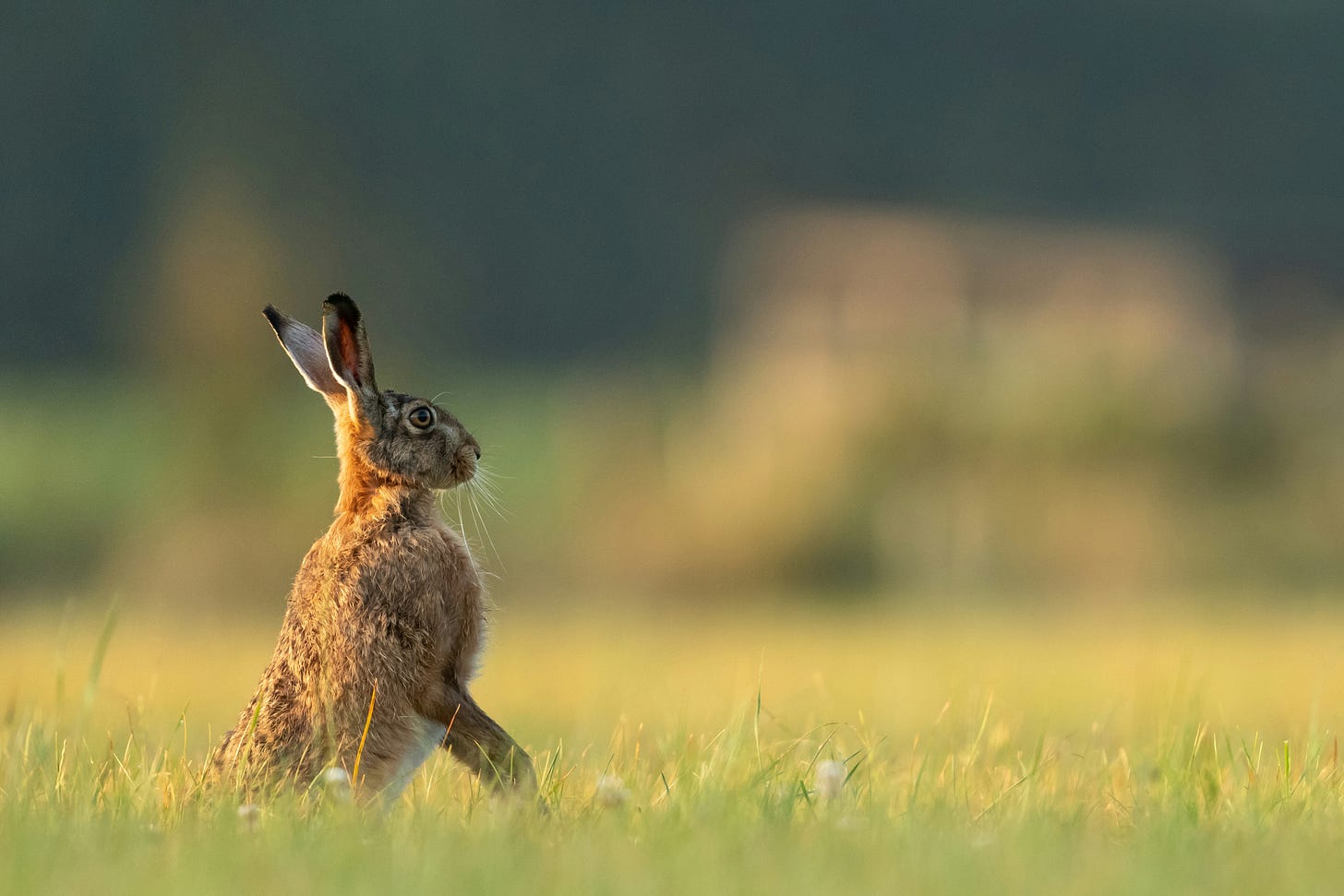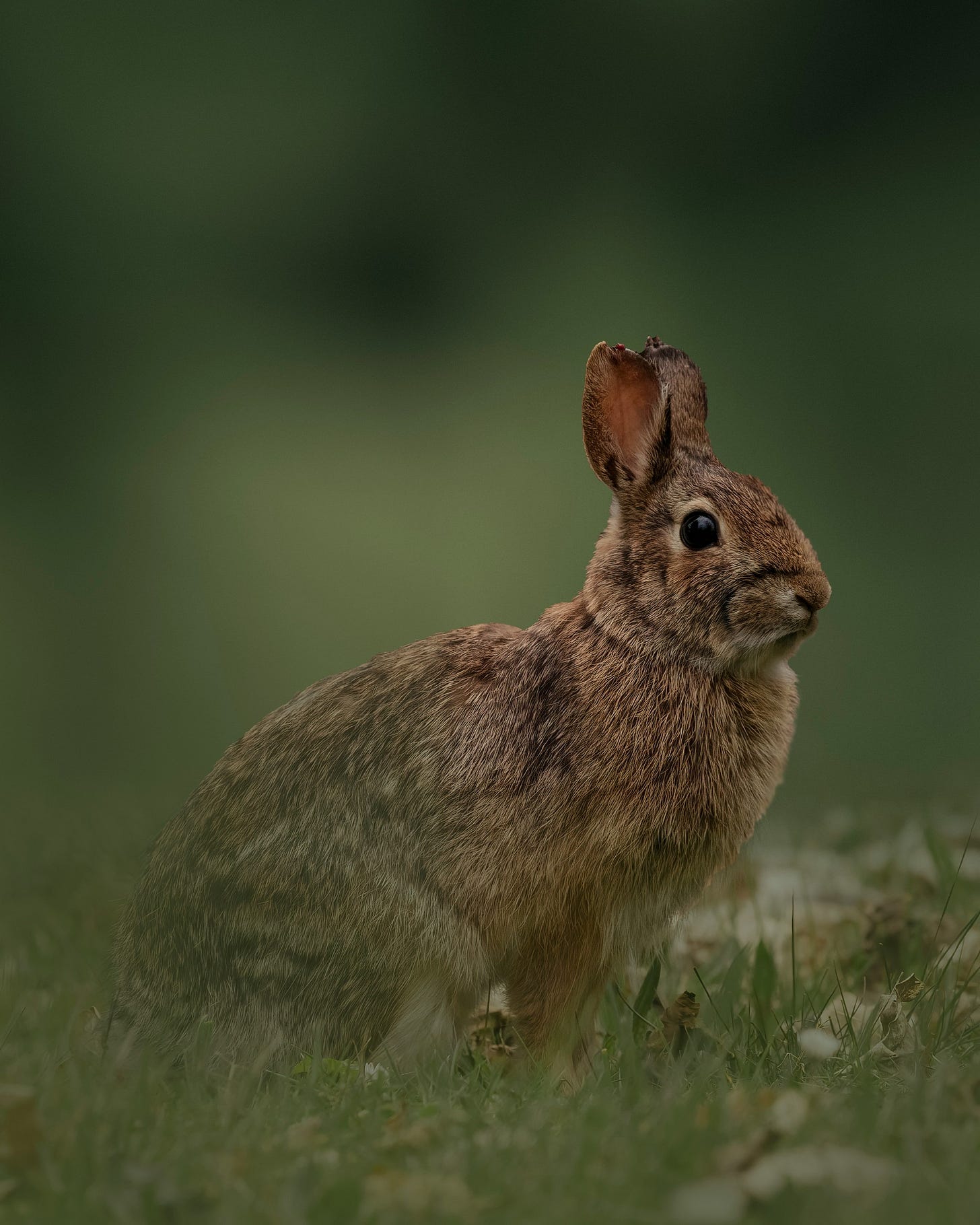
I’ve been trying to remember where I heard a story involving the Easter Bunny, hares and skylarks. In the process of looking for it, I came across this tale of Ostara and The White Hare (in which the Germanic goddess associated with spring turns a bird into a hare and - spoiler alert - the hare lays a clutch of eggs). Apparently this story has “no basis in any authentic, pre-Christian folklore, myth or religion and only appears to date from 1883,” but it’s a good story - and how authentic can a story about a hare laying eggs be anyway?!
After further extensive research (aka frantic Googling over a cup of tea in bed this morning), I think the Easter Bunny story I’d heard was actually about lapwings, not skylarks. Either way, it seems that people have been giving eggs as Easter gifts for a very long time, and lapwing eggs were a favourite because lapwings (and skylarks!) nest on the ground. Hares also shelter on the ground, in shallow depressions or flattened grass nests called ‘forms’ in open fields - the same places you’d find a lapwing (or a skylark). Sometimes, instead of building their own nests, lapwings will use a hare’s form. So I guess people who were out casually stealing eggs from nests for Easter gifts would occasionally stumble across a hare with eggs in its form and assume the hare had laid the eggs.
I knew lapwings were in decline due to farming and grassland management, but I had no idea their eggs were also stolen by humans for food in earlier times. It seems the bird itself was also killed and eaten as a countryside delicacy. So much so that the government passed the Protection of Lapwings Act in 1926 to make it illegal to offer the bird for human consumption or wilfully disturb its nest. Despite this, according to some sources I found, lapwing eggs were knowingly taken during World War 2 and turned into a powder to be consumed by soldiers on the frontline.
HAPPY EASTER!

Some slightly less depressing facts about rabbits and hares for Easter
We have three members of the Lagomorpha (meaning "hare-shaped") order of mammals in the UK: the brown hare, Lepus europaeus; the mountain (or Irish) hare, Lepus timidus; and the European rabbit, Oryctolagus cuniculus.
Rabbits were first introduced to the UK by the Normans in the 12th century for the purposes of food and fur. Hares are thought to have been brought to the UK by the Romans, around 2,000 BP, or perhaps even by an earlier civilisation.
Although there are now thought to be something like 36 million wild rabbits in the UK, they are in decline. The rural population fell by two-thirds (67%) between 1995 and 2022. Brown hares don’t fare much better. During the late 1800s there were about four million brown hares in Britain, but recent surveys show their numbers have declined by more than 80% during the past 100 years. Mountain hares are also severely in decline. The British Trust for Ornithology’s Breeding Bird Survey, which records mammals a well as birds, shows a decline of 61% between 1995 and 2022. This species can only be found in the Highlands, Borders and south-west of Scotland, the Isle of Man, and throughout Ireland. OK, these facts are still depressing aren’t they? Sorry.
Rabbits produce one litter of between three and seven babies every month during the breeding season.
A male rabbit is called a ‘buck’, a female rabbit is called a ‘doe’ and a baby rabbit is called a ‘kitten’ or ‘kit’.
Rabbits live in ‘warrens’, hares shelter in 'forms', which are shallow depressions in the ground or grass.
The European rabbit's Latin name, Oryctolagus cuniculus, translates roughly as 'hare-like tunnel digger,' which refers to their warrens.
In relation to my story above about hares and lapwings… the Easter Bunny is now a rabbit, not a hare, because hares were heavily associated with Paganism, meaning they were not a suitable symbol for a Christian festival!

Sources & Further Reading
Who hatched here? How to identify bird egg shells (Woodland Trust)
The Wildlife Trusts: Brown Hare
The Wildlife Trusts: Mountain Hare
Hare Preservation Trust: Brown Hare
John R Cammidge: Lapwings as a delicacy
Lapwing: Farmer’s Friend booklet
People’s Trust for Endangered Species: Rabbit
People’s Trust for Endangered Species: Brown Hare
People’s Trust for Endangered Species: Mountain Hare
RSPB Community: The real Easter Bunny
The tale of Ostara and The White Hare
Also in season…
A Spring Equinox / Ostara Zine
Tomorrow (20th March 2025) is the Spring Equinox, or Ostara - the start of astrological spring. This is the perfect time to embrace the outdoors, sow some seeds and think about what you’d like to leave behind in winter or bring into your life this spring. With that in mind, I made a little zine to help you (and me) celebrate.







Fun fact: we have to call rabbits, bunnies here or it brings bad luck to the quarries 😅
Love this, as per. Forgot I recorded some lapwings for you whilst I was away! Thankfully plenty of hares about in the East, and rabbits too 😊